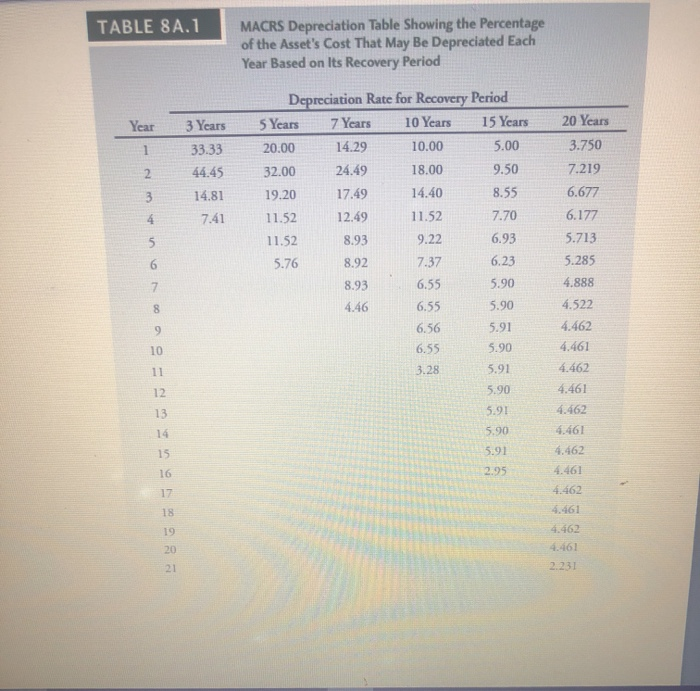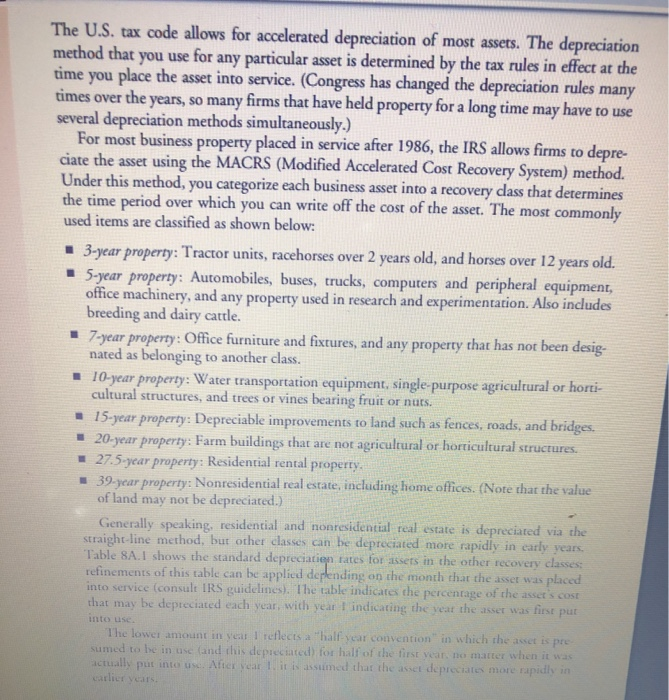use table 25.1 and change the depriqction rate and method from 5 years to dtraight line MACRS. I have attached MACRS INFO . PLEASE show the spredsheet calculating the amount of the depreciation tax shield

TABLE 25.1 SPREADSHEET Cash Flow (5) Consequences from Leasing Versus Buying Year 0 (50,000) Additional Assumptions Debt Cost of Capital (Pretax) Corporate Tax Rate Buy Capital Expenditures 2 Depreciation Tax Shield at 25% Free Cash Flow (Buy) Lease Lease Payments Income Tax Savings at 25% Free Cash Flow (Lease) (50,000) Debt Cost of Capital (AlterTax) Capital Expenditures Lease Payments Straigth Line Years of Dep (12,000) (12,000) (12,000) (12,000) (12,000) (12,000) (12.000) (12,000) (12.000) (12.000) 50,000 12,000 TABLE 8A.1 MACRS Depreciation Table Showing the Percentage of the Asset's Cost That May Be Depreciated Each Year Based on Its Recovery Period 3 Years 33.33 44.45 14.81 7.41 Depreciation Rate for Recovery Period 5 Years 7 Years 10 Years 15 Years 20.00 14.29 10.00 5.00 32.00 24.49 18.00 9.50 19.20 17.49 14.40 8.55 11.52 12.49 11.52 17.70 11.52 8.93 9.22 6.93 5.76 8.92 8.93 5.90 4.46 5.90 6.56 5.91 7.37 6,23 20 Years 3.750 7.219 6.677 6.177 5.713 5.285 4.888 4.522 4.462 4.461 4.462 4.461 4.462 4.461 4.462 4.461 5.90 3.28 5.91 5.90 5.91 5.90 5.91 2.95 4.462 4.461 4.461 2.231 The U.S. tax code allows for accelerated depreciation of most assets. The depreciation method that you use for any particular asset is determined by the tax rules in effect at the time you place the asset into service. (Congress has changed the depreciation rules many times over the years, so many firms that have held property for a long time may have to use several depreciation methods simultaneously.) For most business property placed in service after 1986, the IRS allows firms to depre- ciate the asset using the MACRS (Modified Accelerated Cost Recovery System) method. Under this method, you categorize each business asset into a recovery dass that determines the time period over which you can write off the cost of the asset. The most commonly used items are classified as shown below: | 3-year property: Tractor units, racehorses over 2 years old, and horses over 12 years old. | 5-year property: Automobiles, buses, trucks, computers and peripheral equipment, office machinery, and any property used in research and experimentation. Also includes breeding and dairy cattle. 7-year property: Office furniture and fixtures, and any property that has not been desig- nated as belonging to another class. 10-year property: Water transportation equipment, single purpose agricultural or hort- cultural structures, and trees or vines bearing fruit or nurs. 15-year property: Depreciable improvements to land such as fences, roads, and bridges. 20-year property: Farm buildings that are not agricultural or horticultural structures. 27.5-year property: Residential rental property. 39-year property: Nonresidential real estate, including home offices. (Note that the value of land may not be depreciated.) Generally speaking, residential and nonresidential real estate is depreciated via the straight-line method, but other classes can be depreciated more rapidly in early years. Table 8A. I shows the standard depreciation rates for assets in the other recovery classes refinements of this table can be applied depending on the month that the asset was placed into service (consult IRS guidelines). The table indicates the percentage of the asset's cost that may be depreciated each year, with year indicating the year the asset was first put into use. The lower amount in year I reflects a "half your convention in which the asset is pre sumed to be in use and dis depreciated for half of the first year no matter when it was actually put into us. After year it is assumed that these depreciate more rapidly in carlier years










